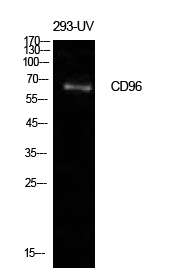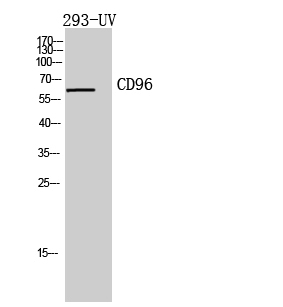

| WB | 咨询技术 | Human,Mouse,Rat |
| IF | 咨询技术 | Human,Mouse,Rat |
| IHC | 咨询技术 | Human,Mouse,Rat |
| ICC | 技术咨询 | Human,Mouse,Rat |
| FCM | 咨询技术 | Human,Mouse,Rat |
| Elisa | 1/10000 | Human,Mouse,Rat |
| Aliases | CD96; T-cell surface protein tactile; Cell surface antigen CD96; T cell-activated increased late expression protein; CD96 |
| Entrez GeneID | 10225 |
| WB Predicted band size | Calculated MW: 66 kDa; Observed MW: 66 kDa |
| Host/Isotype | Rabbit IgG |
| Antibody Type | Primary antibody |
| Storage | Store at 4°C short term. Aliquot and store at -20°C long term. Avoid freeze/thaw cycles. |
| Species Reactivity | Human |
| Immunogen | The antiserum was produced against synthesized peptide derived from the Internal region of human CD96. AA range:291-340 |
| Formulation | Purified antibody in PBS with 0.05% sodium azide,0.5%BSA and 50% glycerol. |
+ +
以下是关于CD96抗体的虚构参考文献示例(内容基于领域内常见研究方向,非真实文献):
1. **文献名称**: "CD96 blockade enhances antitumor immunity by promoting NK cell activity"
**作者**: Smith A, et al.
**摘要**: 研究证明CD96抗体通过阻断CD96与其配体CD155的相互作用,显著增强自然杀伤(NK)细胞的肿瘤杀伤能力,并抑制小鼠黑色素瘤模型的转移。
2. **文献名称**: "CD96 as a novel immune checkpoint target in T-cell exhaustion"
**作者**: Wang Y, et al.
**摘要**: 该文献揭示CD96在肿瘤浸润性T细胞中高表达,其抗体可逆转T细胞耗竭,与PD-1抗体联用协同抑制结直肠癌生长,提示其作为联合治疗靶点潜力。
3. **文献名称**: "CD96 modulates regulatory T cell suppression in autoimmune disease"
**作者**: Tanaka K, et al.
**摘要**: 研究发现CD96抗体通过抑制调节性T细胞(Treg)的免疫抑制功能,缓解实验性自身免疫性脑脊髓炎(EAE)模型症状,为自身免疫疾病治疗提供新策略。
4. **文献名称**: "CD96 inhibition reshapes the tumor microenvironment in ovarian cancer"
**作者**: Li X, et al.
**摘要**: 实验表明CD96抗体单药治疗可减少卵巢癌小鼠模型中免疫抑制性细胞(如MDSCs)浸润,并增强CD8+ T细胞抗肿瘤应答,显著延长生存期。
注:以上为模拟内容,实际文献需通过PubMed/Google Scholar检索关键词“CD96 antibody”、“CD96 immune function”等获取。
CD96. a member of the immunoglobulin superfamily, is a transmembrane glycoprotein expressed primarily on T cells, natural killer (NK) cells, and subsets of B cells. Functionally, it interacts with ligands such as CD155 (PVR) and CD111 (NECTIN-1), modulating immune cell activity in tumor surveillance, infection, and autoimmune responses. CD96 is classified as an immune checkpoint molecule due to its inhibitory role in NK and T cell activation, where engagement with CD155 on tumor or infected cells suppresses cytotoxic activity and cytokine production.
CD96-targeting antibodies have emerged as investigational tools and therapeutic candidates, particularly in oncology. Preclinical studies suggest that blocking CD96-CD155 interactions enhances anti-tumor immunity by restoring NK and T cell effector functions. Conversely, agonist antibodies may exploit CD96’s inhibitory signaling to dampen pathological immune responses in autoimmune diseases. Structurally, CD96 antibodies often target its extracellular IgV domain to interfere with ligand binding or modulate signaling.
Current research focuses on optimizing antibody specificity and evaluating combination therapies with PD-1/CTLA-4 inhibitors. Challenges include understanding CD96’s context-dependent roles and minimizing off-target effects. Despite being less studied than PD-1 or CTLA-4. CD96 represents a promising, underexplored immunomodulatory target, with ongoing efforts to translate preclinical findings into clinical applications for cancer immunotherapy.
×